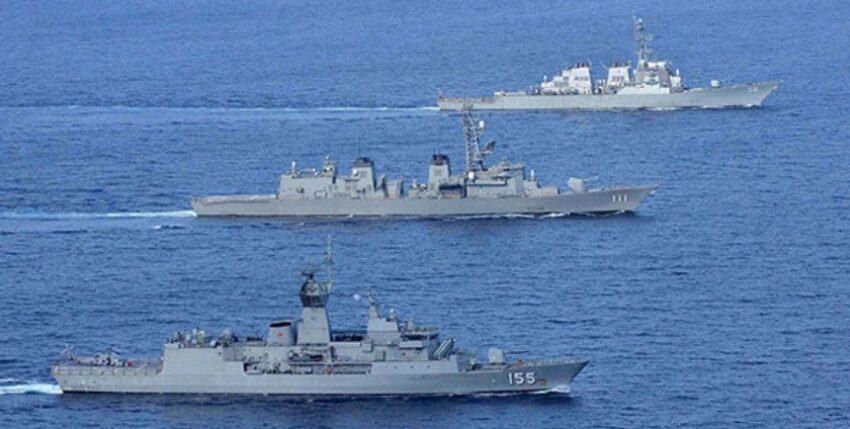In view of the growing threat situation in the region, Japan is modernising its navy. In-house developments are being supplemented by purchased technology in the best possible way.
Japan has the sixth longest coastline and the sixth largest Exclusive Economic Zone in the world. More than 90 per cent of Japan's foreign trade is conducted by sea. In line with its maritime interests and the exposed position of the island state, Japan maintains the second largest navy in Asia. The Japanese Maritime Self-Defence Force (Kaijo Jieitai) - known internationally as the Japanese Maritime Self-Defence Force (JMSDF) - currently has a total of 155 units, including supply vessels, patrol vessels and auxiliary vessels. The vast majority of the fleet is domestically produced. The majority of the ships are less than 20 years old and equipped with state-of-the-art technology. Nevertheless, Tokyo is currently undertaking a further modernisation of its fleet. At the same time, defence policy and military operational doctrine are being adapted to the realities of the 21st century.
New horizons
For decades, the Japanese military was guided by a purely defensive operational doctrine. Over the past decade, Tokyo has modified its comprehensive national security strategy and later its defence guidelines in response to the growing threat from China, North Korea and Russia. Although Japan continues to renounce any form of military aggression, the ability of the armed forces to conduct offensive tactical operations at greater distances from the main islands is being expanded. What is needed is not only large-scale warfare in the East China Sea, but increasingly the ability to engage high-value military targets in enemy territory. As the air force does not have long-range bombers, this capability lies exclusively with the navy.
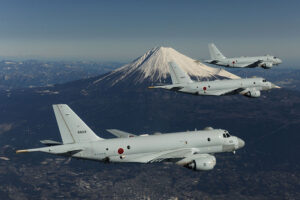
Today, Tokyo declares its willingness to assume responsibility as a regional power in line with the country's economic power. However, Japan is prioritising security and military cooperation with like-minded powers. Of 82 JMSDF exercises and training cruises in 2021, more than 70 involved at least one foreign partner. The closest cooperation is with the US Navy and the Australian Navy. In recent years, Japan has also been systematically expanding bilateral and multilateral maritime security cooperation with India, South Korea and Europe.
The Japanese military also supports and promotes the armed forces of smaller countries in Southeast Asia and the South Pacific region through training, material assistance and a visible presence. For more than a decade, the JMSDF has also been involved in multinational operations outside its immediate area of responsibility. Since 2009, this has included participation in the Combined Task Force 151, which serves to curb piracy in the Gulf of Aden and off the Somali coast. In 2015, a Japanese officer took command of CTF 151, marking the first time that Japanese forces have led a multinational force.
Naval structure
The Japanese defence budget for 2022 amounts to 47 billion dollars. This is the eighth consecutive year in which military spending has reached a new high. A considerable proportion of the money is being channelled into increasing the fleet's capabilities by procuring and developing new operational systems and researching future technologies. Many of the navy's operational systems already in service are also being upgraded through modifications and the introduction of new on-board systems.
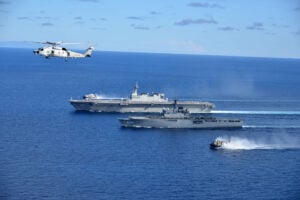
The combat units of the JMSDF are divided into territorial defence forces and the self-defence fleet. The country's main islands are divided into five naval districts whose task is to protect the neighbouring territorial waters. To this end, each district is equipped with a coastal defence squadron consisting of three destroyers and mine countermeasures vessels. The destroyers generally belong to the older series of the fleet. These multi-purpose combat ships are capable of engaging surface and underwater targets as well as air targets.
However, the main combat strength of the JMSDF lies in the self-defence fleet intended for use on the high seas. It is divided into surface and submarine forces and naval aviation. The surface forces are divided into four operational flotillas. Each flotilla consists of two squadrons of four destroyers each. In addition to one helicopter carrier each, the flotillas also have two guided missile destroyers and five guided missile destroyers. The submarine forces are also divided into two flotillas. Each is in turn divided into three squadrons with an average of three submarines. The naval aviation comprises around 200 fixed-wing aircraft and 145 helicopters. The aeroplanes are divided into seven squadrons. Their main tasks are maritime reconnaissance and submarine hunting.
Modernisation of the navy
Japan has four helicopter carriers, the largest units in the fleet. Although the ships are not equipped with offensive guided missiles or guns, they are referred to as helicopter-carrying destroyers. This takes account of the ban on the procurement of offensive weapons systems enshrined in Article 9 of the Constitution and is intended to avoid any reminiscence of the offensive aircraft carriers of the Second World War.
Two units belong to the HYUGA class (197 m long, 14,000 tonnes displacement), which was launched in 2009. These ships are primarily designed for submarine hunting and carry a maximum of 18 helicopters. They are armed with torpedo tubes and the RUM-139 anti-submarine missile system. Both units are equipped with the Japanese Atecs (Advanced Technology Command System) and can lead a warship formation or a humanitarian operation.
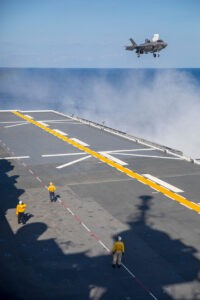
Launched in 2015, the IZUMO class is the largest of the JMSDF with a length of 248 metres and a displacement of 19,500 tonnes. Although these units do not have ASW torpedoes, they can carry up to 28 vertical take-off aircraft. In 2018, the Japanese cabinet decided to reorganise the IZUMO class to also accommodate F-35B fighter-bombers. For political reasons, however, the ships will henceforth be referred to as multi-role destroyers rather than light aircraft carriers.
Thanks to the combination of stealth, advanced sensors and stand-off weapons, the carrier-based F-35Bs will give the Japanese fleet a power projection capability not seen since World War II to engage attackers at a great distance from the Japanese islands. The new core capability also means an expanded dimension for operational co-operation with the US Navy and other allied or friendly naval forces. In future, American or British F-35Bs could also land on Japanese ships for resupply during joint missions. The ability to protect Japanese interests in distant regions such as the Indian Ocean will also be strengthened.
The refit of the ships comprises the reinforcement of the flight deck and the conversion of the hangar deck and is being carried out in two phases. Phase one was completed in 2021 on the type ship IZUMO. The F-35B on board this ship was flown for the first time in October 2021 by US Navy aircraft to confirm its operational readiness as an aircraft carrier. The Japanese armed forces will receive the first of a total of 42 fighter-bombers on order in 2023. The standard squadron of an IZUMO carrier will consist of at least twelve F-35Bs as well as a number of sub-hunting and multi-role helicopters.
In view of the regional threat posed by ballistic missiles from North Korea and China, the Japanese navy places a high priority on maritime defence against ballistic missiles. The Ballistic Missile Defence (BMD) is intended to defend both the fleet and the Japanese islands. For this purpose, the JMSDF has eight guided missile destroyers equipped with the Aegis guidance system. These units belong to a total of three ship classes. The two MAYA-class units were commissioned in 2020 and 2021 respectively, making them among the navy's newest ships. The equipment of the 170-metre-long ships with a displacement of 8,200 tonnes includes the latest Aegis variant Baseline 9C (Japanese designation J7), the Aegis BMD 5.1 ballistic missile defence version, the SPY-1D(V) radar system and the AN/SPQ-9B fire control radar operating in X-band. The vertically aligned silos carry missiles of the SM-3 Block IIA type, among others. This weapon was developed jointly by Japan and America to combat short- and medium-range ballistic missiles. The missile has a range of 1,350 nautical miles and achieves a speed of Mach 13. The additional introduction of SM-6 on the MAYA class was decided in 2021. It is primarily designed to engage conventional air targets such as aircraft and cruise missiles at ranges of up to 200 nautical miles. To engage maritime targets, the MAYA class also carries older Type 90 maritime target missiles with a range of 80 nautical miles and the new Type 17 with a range of 216 nautical miles. Finally, the propulsion and power generation system is designed to enable future retrofitting with laser weapons or rail guns.
An even more advanced destroyer class of the next technological generation is also to be designed. Only two units are planned to be procured. The main mission is to protect the Japanese islands from medium-range ballistic missiles, hypersonic glide missiles and cruise missiles. The ships are to be equipped with the modified AN/SPY-7(V)1 solid-state radar. It is not expected to be introduced until the end of the decade.
The JMSDF also has five classes of guided missile destroyers, currently totalling 28 units. The primary mission of these multi-purpose ships is to protect the helicopter carriers and BMD-capable guided missile destroyers by engaging sea, air and underwater targets. The most modern guided missile destroyers belong to the three-ship AKIZUKI class, which was commissioned in 2012 and focuses on air defence, and the two-ship ASAHI class, which was launched in 2018 and is optimised for submarine hunting. The AKIZUKI class is equipped with the Atecs command and control system. This forms the operational network of all weapons and sensors to ensure efficient engagement of threats at all levels and is often compared to the American Aegis system.
Frigates and submarines
The new multi-purpose frigates of the MOGAMI class are to replace the destroyers introduced to the fleet before the turn of the millennium. They have a displacement of 3900 tonnes. The first ship in this class, the KUMANO, was commissioned in March 2022. A total of 22 units are to be acquired by 2032.
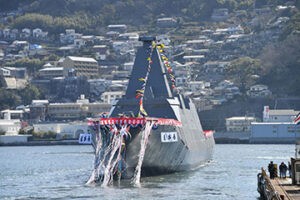
The 133-metre-long hull was designed according to the latest findings in order to minimise the radar signature. All superstructures are combined into a sloping block to minimise the number of surfaces. The pyramid-shaped sensor mast is also designed to make detection by the enemy more difficult. Thanks to a high degree of automation, a crew of 90 can operate the frigates. Destroyers with a similar displacement otherwise require 200 crew members. The integrated operations centre has a 360-degree display running along all four walls, providing a view of the surrounding waters and airspace; detected objects are digitally processed and displayed in detail.
The frigates are intended to support the destroyers and carriers in the fleet. The planned range of missions includes submarine hunting and air and missile defence as primary tasks. Combating mines is considered a secondary task. They can also be deployed individually for reconnaissance and surveillance. The ability to operate unmanned surface and underwater vehicles was planned from the outset. The standard armament includes eight Type 17 anti-ship missiles and the maritime variant of the Chu-SAM medium-range surface-to-air missile, which is still in the planning stage.

The fighter submarine fleet comprises 22 units of three classes. These boats, armed with torpedoes and Harpoon anti-ship missiles, are considered the most important type of weapon for keeping an enemy at a distance from Japanese waters.
Launched in 1998, the OYASHIO class displaces 4000 tonnes when submerged and reaches a maximum of 20 knots. Two of the eleven units built have since been handed over to the training flotilla. The gradual decommissioning of further units is planned.
The twelve units of the SORYU class launched in 2009 have a payload capacity 50 per cent greater than that of the OYASHIO class. The last two units of the SORYU class are the first Japanese submarines to use lithium-ion batteries. These have almost twice the storage capacity of conventional lead-acid batteries and therefore enable a longer operating life under water.
The type ship of the new TAIGEI class was put into service in March 2022. This type of boat also uses lithium-ion batteries. It also has a new battle management system, new sonar equipment and a defence system against enemy torpedoes. The TAIGEI class is also quieter and more manoeuvrable than the SORYU class. Seven units are to be procured. The type ship will serve as a test ship for advanced weapons and on-board systems.
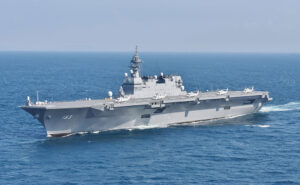
The Japanese P-3 Orion maritime patrol aircraft are currently being replaced by the Kawasaki P-1. Around a third of the approximately 90 planned P-1s are already in service. The jet aircraft, which was developed specifically as a maritime patrol aircraft, is the first production aircraft in the world to use a fly-by-light control system. The signals are transmitted from the cockpit to the relevant systems via fibre optic cable, which makes the aircraft less susceptible to electromagnetic interference or the effects of an electromagnetic pulse. The tactical systems are equipped with the highest level of artificial intelligence to relieve the tactical officer and ensure fast, precise mission control. State-of-the-art mission systems have been integrated, including the Toshiba AESA radar system with additional antennas on both sides of the bow to increase detection range. The service ceiling of the four-engine jet aircraft is 13,500 metres - around 50 percent higher than that of a P-3 - and the detection range of the sensors is correspondingly greater.
Armed for the future
The introduction of new ships and aircraft is only one part of Japan's modernisation strategy. The overarching goal is to create a tactical engagement capability both within the Japanese armed forces and with allies. Sensor data from the various ships and aircraft is to be freely exchanged to enable coordinated engagement of enemy targets by on-board weapons from different units.
Long-range reconnaissance and homing sensors as well as precision weapons are regarded as indispensable elements of such a combat-enhancing network. The JMSDF want to introduce unmanned reconnaissance and surveillance systems, not least to locate targets for sea- and air-based stand-off weapons. These include long-range land-based systems and ship-based systems as over-the-horizon reconnaissance aircraft. Unmanned surface and underwater systems equipped with high-performance sonar are also to be used for mine clearance operations.
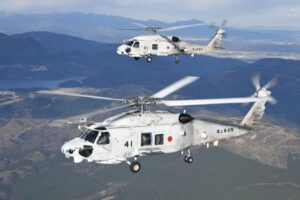
New, long-range precision weapons also serve to increase combat effectiveness. Among other things, the acquisition of the Kongsberg Joint Strike Missile for engaging sea and land targets has been decided; according to the manufacturer, the weapon, which can be deployed by the F-35B and the P-1, has a range of more than 100 nautical miles. Towards the end of the decade, a new cruise missile with a range of 600 to 800 miles is also to be introduced, which can be deployed from ships and submarines. Equipped with a low radar signature, the weapon is designed to engage sea and land targets. The ability to attack enemy land targets could already act as a deterrent and offers a significant tactical advantage compared to the current situation.
Overall, Japan's Ministry of Defence attaches great importance to forward-looking development and procurement planning, taking into account the current armament programmes of potential opponents. This is intended to ensure that the fleet is also geared towards the current strategic and tactical environment in the coming decades.
Sidney E. Dean

